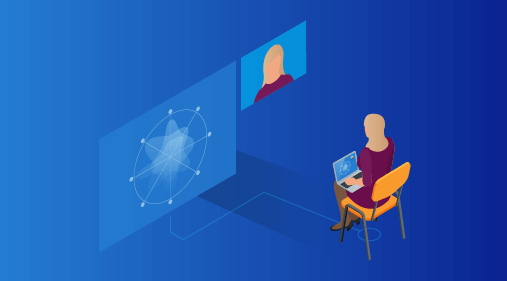Pros and cons of one-way video interviews with candidates
One-way video interviews offer a convenient and efficient way to screen candidates, particularly those who are remote. They speed up the hiring process, facilitate structured interviews, and promote team collaboration. However, they may limit real-time interaction and relationship building, and some candidates may find them uncomfortable.

As technology advances and becomes more accessible, the set of tools available to recruiters gets larger. Asynchronous interviews, also called one-way video interviews, are just one example.
Instead of struggling to schedule interviews at a time that works for everyone, both sides can participate in an interview that works with their own schedule. Hiring teams can evaluate candidates at a time of their choosing, and those candidates already in employment don’t need to struggle to schedule interview time into their working day.
Here’s how to benefit from pre-recorded video interviews and how to overcome their limitations:
Contents
What are the benefits of one-way video interviews?
Pre-recorded video interviews are usually scheduled at the early stages of the hiring pipeline and help you screen candidates faster and more objectively. When you conduct one-way video interviews, you’re able to:
Connect with remote candidates. Distance is no longer an issue when using video interviews. You don’t have to rely only on local talent or worry about bringing remote candidates in for interviews. And one-way interviews specifically resolve any problems created by time zone differences. Asynchronous communication enables interviewers and candidates to ‘speak’ to each other without having to join the interview at unsociable hours (like late at night.) This helps busy hiring managers, who can view all candidates’ recordings at a convenient time, and recruiters, who might be hiring for various open roles and struggle coordinating different time zones.
Speed up the hiring process. Imagine you want to screen twenty candidates for one position. If you’re doing this over the phone, you need to make twenty separate calls. But, if you’re using one-way video interview software, you only need to write or record your questions once and send them to candidates. To evaluate candidates’ answers, you’ll watch twenty videos, which is faster than scheduling and conducting the same number of live interviews. Plus, you can replay the recordings as many times as you want to ensure you don’t miss anything.
Screen candidates more effectively. During the initial phases of the hiring process, you usually want to address any deal breakers. In some cases, it’s easy to do that with a simple application form. (For example: ‘Do you own a valid driver’s license?’) Other times, a pre-recorded video interview will help you dig into your candidates’ skillset. For example, if you want someone to be fluent in French, ask them to answer your questions in French. Or, if you’re hiring salespeople, you’re able to test their communication and presentation skills.
De-stress the interview process for candidates. Job interviews can be stressful even for the best-prepared candidate. And stress hinders interview performance, running the risk of making candidates appear less qualified. With one-way video interviews, you can create a better candidate experience to aid your decision-making. Explain to candidates that they can record as many takes as they want and that you’ll only view the final one that they choose to submit. This way, they can rehearse until they’re satisfied with their answers and feel more confident that they’ve presented their best self.
Evaluate candidates using structured interviews. Structured interviews, where you interview candidates asking the same questions in the same order, lead to more objective hiring decisions. But they often appear cold and rigid as they don’t allow for spontaneity among participants. One-way video interviews are a good turnaround in this case. Candidates know the questions beforehand and have time to prepare their answers, bringing up specific examples that describe their skills and past experiences. And interviewers can compare candidates more objectively as they don’t get influenced from small talk that could happen before or after a live interview.
Work better as a hiring team. Hiring usually requires collaboration between multiple interviewers. One-way video interviews facilitate this collaboration as they help engage all hiring team members early on in the process. They’ll all view the same interview, share their feedback and decide to move forward or reject a candidate as a team. This way, candidates won’t have to go through multiple interview rounds until the last interviewer notices a potential dealbreaker.
The risks of one-way video interviews
Pre-recorded video interviews are useful, but not perfect. When you use this type of interview to evaluate candidates, consider the following limitations:
Candidates might struggle speaking to a ‘machine’. Not all candidates will feel comfortable recording themselves. This could negatively affect their performance. That’s why one-way interviews shouldn’t be your only criterion when rejecting or moving candidates forward. Take their entire profile into consideration. If you’re unsure whether they’re qualified or not after watching their video, it’s best to schedule a call or move them to the next hiring stage. Give them another chance to speak about their skills and then decide whether they’re qualified.
You don’t have the chance to answer questions or promote your company. Interviews don’t just help companies evaluate candidates; they also help candidates learn more about the company and the role. And this is best done through real-time conversations. If you use recorded video interviews during your hiring process, ask candidates to pose their own questions at the end of the video and answer them later. Also, opt for a live (either video or in-person) interview in the final hiring stages to sell your company and open role to your most qualified candidates.
You miss on creating real relationships with candidates. Asynchronous communication shouldn’t be your only contact with candidates, even the ones you reject. You risk giving the impression that you’ve dehumanized the hiring process and that could hurt your employer brand. It’s best to make a quick call or email rejected candidates, share interview feedback and thank them for their time. This way, you reassure candidates that you watched their video and keep communication lines open, in case there’s another, more suitable job opportunity in the future.
Interested in conducting one-way video interviews with candidates? Learn how Workable Video Interviews, our new remote screening tool, can help you keep your hiring on track. Find out more and feel free to reach out if you have any questions.
Frequently asked questions
- What is a one-way video interview?
- A one-way video interview is a method that enables employers to gain insights about a candidate's personality and skills before making a decision on their suitability for the company. It's a flexible approach that accommodates the schedules of both parties.
- Are one-way video interviews good?
- One-way video interviews offer a unique, albeit one-dimensional, way to interview candidates. While they don't provide candidates with an immediate opportunity to ask questions or engage in conversation, they also eliminate the need for hiring managers to invest time in early-stage relationship building with potential employees.
- What is the typical duration of a video interview?
- Video interviews, which may be used in place of in-person interviews for candidates living far away, typically last around 45 minutes. This time frame allows for a comprehensive evaluation of the candidate's skills and qualifications.
- Do one-way video interviews create a barrier for candidates?
- Some candidates may find it challenging to record themselves, which could negatively impact their performance. Therefore, it's essential to consider the candidate's entire profile and not base decisions solely on the one-way interview. If there's uncertainty about a candidate's qualifications after viewing their video, scheduling a call or moving them to the next hiring stage is advisable.
- Do one-way video interviews limit the opportunity to promote the company?
- One-way video interviews don't provide a real-time platform for answering candidate questions or promoting the company. To address this, candidates could be encouraged to pose their own questions at the end of the video, which can be answered later. A live interview in the final hiring stages can also be beneficial for promoting the company and the role to the most qualified candidates.




